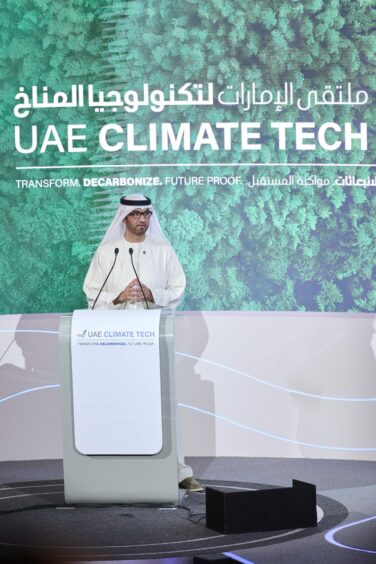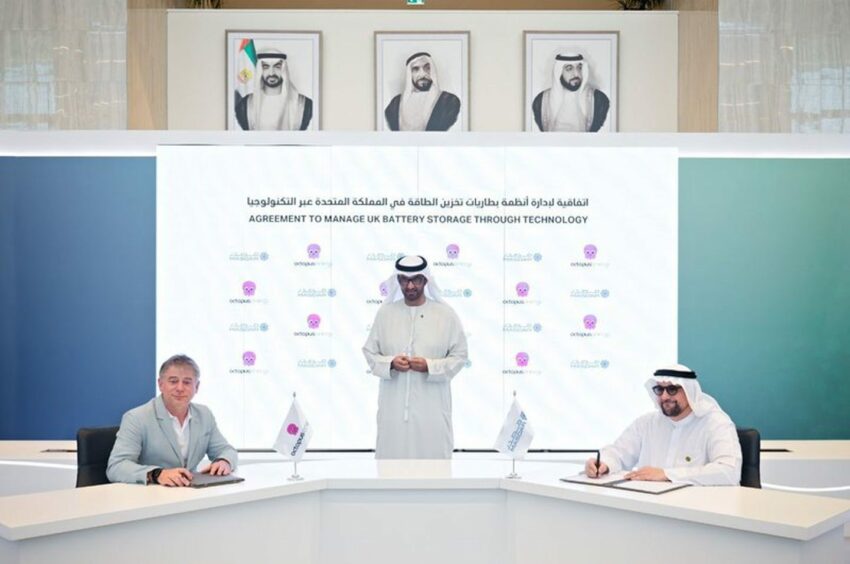[ad_1]
Hydrogen, carbon capture and tackling emissions were the focus of the recently concluded UAE Climate Technology Conference, pointing the way to the upcoming COP28.
At the meeting in Abu Dhabi this week, the COP28 chairman, representing Sultan Al Jaber – who is also Adnoc’s chief executive and Masdar’s chairman – called for attention to the emissions issue. The world must cut emissions by 43% by 2030 to keep the growth target of 1.5 degrees Celsius, he said.
“We need to find a way to curb emissions,” he said. “The most critical source of these solutions is technology.”
Al Jaber said the oil and gas industry should achieve zero methane emissions by 2030 and develop a comprehensive net-zero emissions plan by 2050.
He went on to call for a “new economic model” that includes “ending emissions” and “reinvigorating sustainable economic growth”.
Global renewable energy must triple by 2030 and double again by 2040. However, “renewable energy is not and cannot be the only answer”. COP28 chiefs pointed to the challenges of cement, steel and aluminium, which cannot run on renewable energy.
Hydrogen can play a role here, though, as can carbon capture and storage (CCS).
Al Jaber said that amidst this change, it is most important not to forget less developed countries.
“Developing economies received only 20 percent of cleantech investment last year. These economies account for 70 percent of the world’s population — more than 5 billion people,” he said. “Technology is critical to helping the most vulnerable communities build capacity and leapfrog into a low-carbon economic development model.”
The goal is to “curb emissions, not progress”.
area details
As part of its push for renewable energy, Masdar struck a deal with locally-based IRENA outlining global targets for 2030. Al Jaber, who witnessed the signing of the agreement, said Masdar had committed to 100 GW of renewable energy by the end of this decade.
“As the world gathers at COP28, this joint research project with IRENA will highlight the important role of renewable energy in limiting global warming,” he said.
IRENA Director General Francesco La Camera stated that the world is not on the right track for energy transition. The agency calls for the installation of 1,000 GW of renewable energy per year.
The Masdar-IRENA project aims to establish a global baseline. It will focus on “solar, wind, hydro, geothermal and other technologies, including battery storage, complemented by region-specific data”.
This work aims to highlight the different challenges that different regions must face, and then provide recommendations for next steps.
Al Jaber said November’s COP28 would focus on “how” to achieve the goals set by the Paris Agreement by 2015.
Masdar has shown how it intends to tackle the challenge by signing a licensing agreement with Octopus Energy for its Kraken platform. It said Masdar would use Kraken to manage its battery storage portfolio in the UK.
The Abu Dhabi-based company said it would use the platform to optimize its battery assets to achieve “maximum return” and store electricity in the greenest way possible.
how
Adnoc gives some direction on how to think about its role in future energy systems. The company plans to have an oil production capacity of 5 million bpd by 2027.
Technology will play a key role, Al Jaber said, and Adnoc is looking to innovate in this area. The company announced a $1 million challenge at this week’s event. The plan is to attract innovation to “reshape the global energy landscape”, with support from Amazon Web Services, BP and the Net Zero Technology Center.
Applicants must submit their proposals by August 11th. The 10 finalists will then present their innovations to a small group this December. The winner will receive a $1 million prize and access to research facilities in Abu Dhabi.
Musabbeh Al Kaabi, Adnoc Low Carbon Executive Director, said its aim is to nurture “companies with the most promising innovations that can help transform, decarbonise and future-proof the global energy sector”.
The company listed various technologies it is interested in, including CCS, new energy, emission reduction and advanced materials.
An indication of the use of technology is the signing of an agreement between Adnoc Logistics & Services and SeaOwl. The two companies agreed to collaborate on unmanned Remotely Operated Vehicles (ROVs).
Adnoc L&S says the design will reduce carbon emissions by up to 30%, and the vessel will be lighter and smaller than when it needs to carry a crew. The 55-meter ROV will be operated from an onshore control room using a satellite link.
SeaOwl will design, oversee construction and process sailing permits. The company’s CEO, Xavier Génin, said the project “will create a strong connection with the UAE’s industrial landscape, as we plan to involve many other Emirati players in this exciting journey”.
capture carbon
Shortly before the Climate Tech event, Adnoc announced that it had started injecting CO2 into carbonate brine aquifers. It is a world first and will be scaled up in the second half of this year, the company said.
It laid out its plans at Abu Dhabi Sustainability Week (ADSW) in January. The project will be scaled up to capture 18,000 tonnes of CO2 per year from Fertiglobe’s local operations.
Adnoc currently has the capacity to capture 800,000 tonnes of emissions from steel production at the Al-Reyadah plant. It aims to reach 5 million tons per year by 2030.
The company also announced this week a strategic partnership with LanzaTech. The aim is to use “carbon-consuming biotechnology” to convert the exhaust from Adnoc’s work into something useful.
It will produce chemicals such as ethanol that can be used in a range of products – including sustainable aviation fuel (SAF).
hydrogen hope
Sarah Al Amiri, UAE Minister of State for Public Education and Advanced Technology, has recognized hydrogen as a “critical fuel” for the energy transition.
She pointed to the importance of investing in new technologies for hydrogen. The UAE aims to capture 25 percent of the global market by 2030. Talks at climate tech event cover green and blue hydrogen. There’s also some talk of using nuclear energy to produce resources — sometimes called red or pink hydrogen.
Adnoc showed a desire to make progress, signing an agreement with Baker Hughes for innovation in this area. The agreement points to three technologies in which Baker Hughes has invested. These are in collaboration with Nemesys, a next-generation electrolyser technology company, Methane Plasma Company Levidian and methane cracker Ekona Power.
Levidian said it will deploy one of its Loop20 systems at the Adnoc Gas facility. This will see it conduct field tests of carbon capture through graphene and hydrogen production.
Judging from the tone of this week’s meeting in Abu Dhabi, it was clear that Adnoc has no plans to abandon its oil and gas projects.
It’s also clear that the company — and the UAE — are working on energy development, not revolution.
Given that COP often involves an inevitable cycle of hope and despair, this may be a step forward.
recommended to you

Masdar signs with Adnoc Drilling to advance geothermal
[ad_2]
Source link
 © Courtesy of Emirates Climate Technologies
© Courtesy of Emirates Climate Technologies © Provided by Adnoc / Octopus
© Provided by Adnoc / Octopus